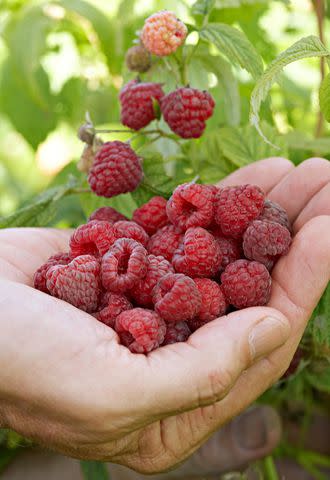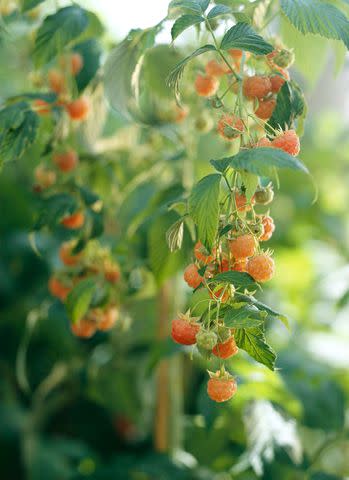How to Plant and Grow Raspberries
Use these tips to grow plenty of sweet, juicy raspberries in your own backyard.
Reviewed by Sylvia Duax
When you know how to grow raspberries for yourself, the possibilities are almost endless: You can make raspberry jam, raspberry liqueur, or enjoy a fresh bowl of raspberries and cream. Treat yourself to a few fresh berries straight from the plant, and freeze any extras that you can’t use before they start to spoil. To help your raspberry plants thrive and produce a bumper crop each year, make sure you choose the best variety for you, plant in a good spot with plenty of sun, and prune them back in the right season so they’ll keep producing fruit year after year.
Where to Plant Raspberries
Raspberries are vigorous growers and will produce runners that fill up a bed. When planning for raspberries, it’s important to make sure you have a roomy spot. They can get relatively large—so be sure you allow for them to grow and spread. Choose a spot in full sun (where the plant will get at least six hours of direct sunlight per day) and well-drained soil; dig in some compost to give them a jump-start.
Thorny raspberries can be planted around the edges of your yard and used like a fence or physical barrier. Avoid planting them near driveways or walkways, however, because of their thorns. Don’t have just the right spot to plant them in the ground? Smaller raspberry varieties are perfect for growing in large containers.

How and When to Plant Raspberries
You can buy raspberries bare-root in the spring or as container-grown plants for spring, summer, or autumn planting. Regardless, plant the canes (branches) 20 inches apart and rows 5 feet apart. The canes will fill in all the available spaces, and all you need to do is dig up those that venture out into the path. Raspberry plants are hardy in USDA Zones 3-9, so once they’re established, you don’t have to worry about replanting them each year.

Raspberry Care Tips
Light
Plant your raspberries in a spot that gets full sun (at least 6 to 8 hours of direct sun per day) to keep your plants healthy and productive. While these fruits tolerate and grow in partial or even full shade, they’re more susceptible to disease and produce fewer and lower-quality berries than when they're grown in the sun.
Soil and Water
Raspberries don’t have particular soil requirements, but like most fruits and vegetables, they do best in moist, well-drained soil that’s rich in organic matter. If your garden soil has a high clay content, amend liberally with organic matter at planting time to help give your berries the best possible start.
Pruning
Pruning raspberries depends on the type you’re growing. For summer-bearing raspberries, it takes two years for each cane to produce fruit. Individual canes grow just leaves the first year, produce fruit the second year, and then die. You can cut second-year canes back to the ground after you’ve harvested all the fruit from them; each cane only produces fruit once. But, be sure to leave all the new canes that come up each year because they’ll produce berries next year. If those first-year canes (also called primocanes) are cut off or die back during winter, your raspberries will not produce fruit because you have no two-year-old canes (called floricanes) left in the patch.
In contrast, fall-bearing raspberry varieties do bear fruit in late summer/early fall on the tips of first-year canes. Those tips die off over the winter, but the rest of the cane fruits the following summer, then dies completely. Because fall-bearing raspberries will give you a second crop the following summer, you can wait to cut down the canes until the next autumn. But here’s a trick used by many raspberry growers: Instead of getting two crops from each cane, prune back all of the canes to the ground in late winter or early spring. The resulting growth will produce one big late crop (and it’s usually larger than the two smaller crops combined).
Trellising
It isn’t necessary to trellis raspberries as long as you have room for the canes to arch slightly as the fruit ripens. A small bed is fine for a freestanding raspberry patch, but trellising does help protect the canes from getting damaged by storms. If you want to grow a row or two or you prefer a tidier look in the garden, install a wire fence with two or three vertical wires attached to T-bar posts at the ends of the rows so the canes grow up supported by wires on either side.
Related: What’s a Bramble? Plus, the Best Ones to Grow in Your Backyard
Pests and Problems
Powdery mildew is a common disease for raspberries. To keep this disease to a minimum, choose disease resistant varieties, leave at least 2 feet of space between plants to allow for good air flow, and prune off old fruiting canes after the last harvest. And cleaning up any fallen fruits and dead leaves around the plants will help control both mildew and raspberry rust, a disease that produces rusty dots on the leaves.
Harvesting Raspberries
Harvest raspberries by gently tugging off the berries. They don’t have a long shelf life, so eat the fruit fresh off the plants, store in the refrigerator up to three days, or freeze as soon as you’re able.
You might see a misshapen raspberry here and there; a berry that is drawn up on one side or another. That’s the result of poor pollination, which could be caused by a cold, wet spring. You might consider keeping mason bees, which emerge earlier than honeybees and do a great job at pollinating all sorts of plants, even in cool weather.
Raspberries are one of the easiest, most rewarding, and most productive fruits you can grow at home. Once you know how to grow and care for raspberries, you’ll be enjoying this delicious, healthy fruit fresh from your garden all season long.
Types of Raspberries
The first step in growing raspberries is choosing the right type for you. There are two different categories of raspberries: Summer-bearing and fall-bearing (also called everbearing). Summer-bearing plants produce one big crop of fruits in late summer. Fall-bearing plants produce two crops a year: one in early autumn and a smaller crop early the next summer.
Raspberries come in three common colors: red (varieties such as ‘Latham’, ‘Autumn Bliss’, and ‘Heritage’), black (varieties such as ‘Blackhawk’ and ‘Bristol’, not to be mistaken with blackberries), and yellow (varieties such as ‘Honeyqueen’ and ‘Fallgold’). In general, red raspberries are stronger, hardier, and more productive than the black and yellow raspberry plants.
For more Better Homes & Gardens news, make sure to sign up for our newsletter!
Read the original article on Better Homes & Gardens.
